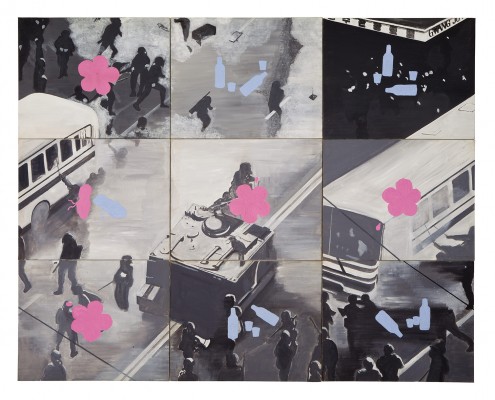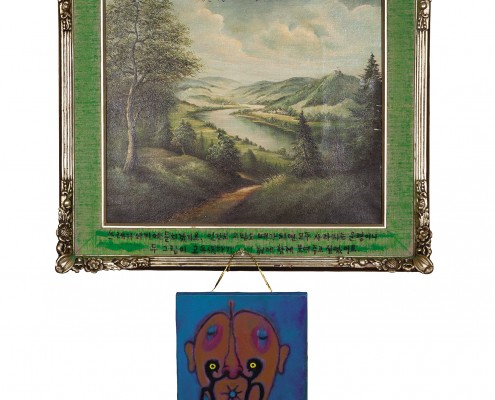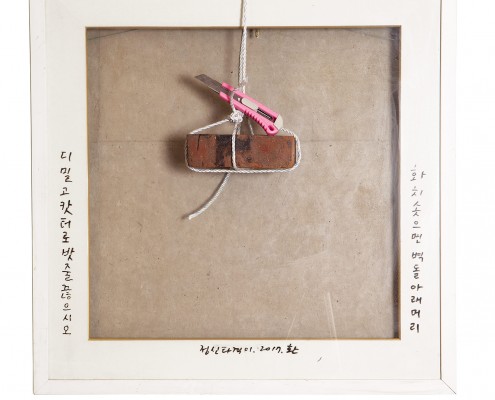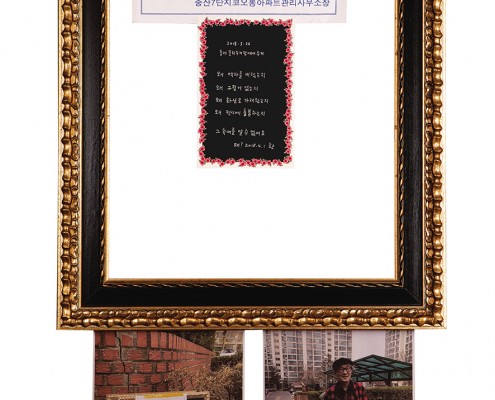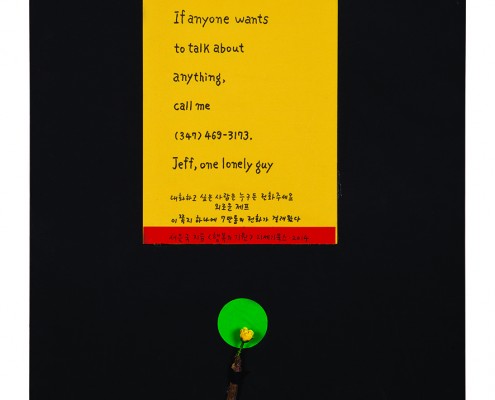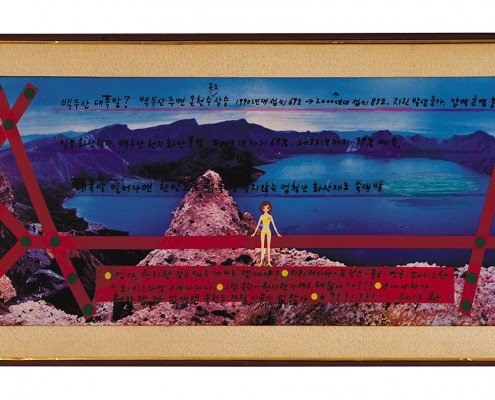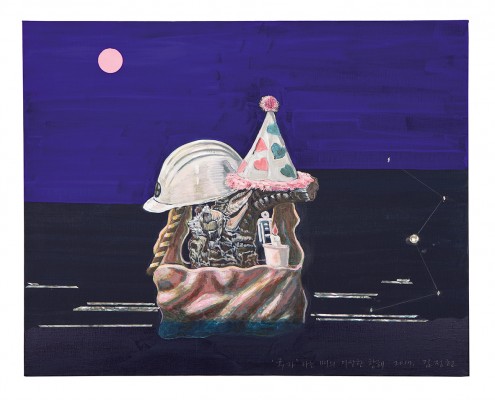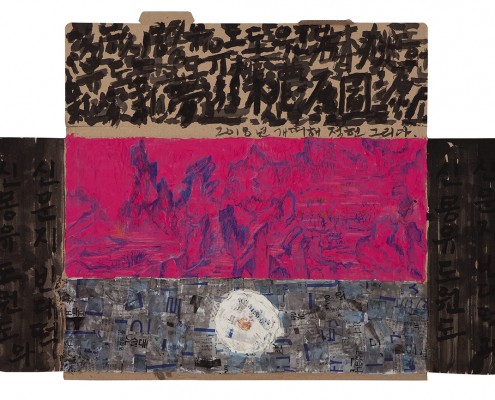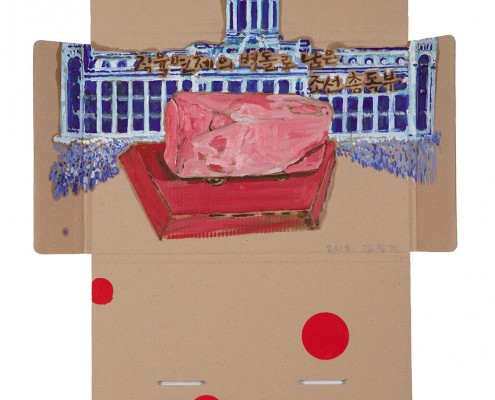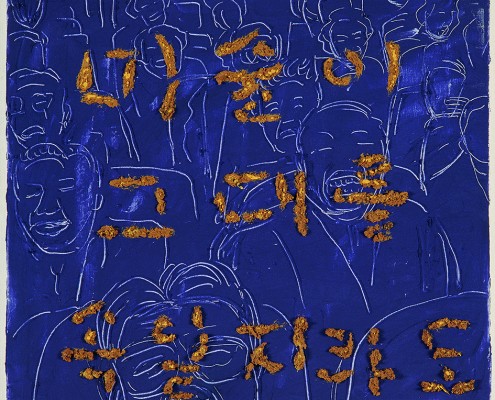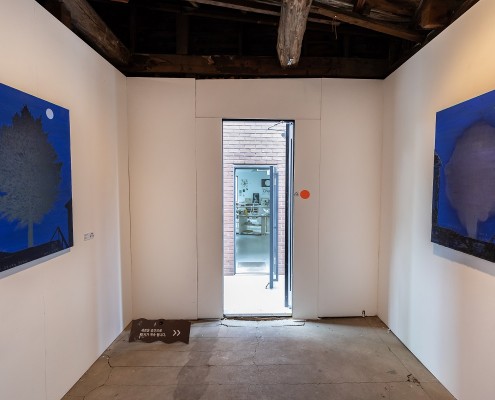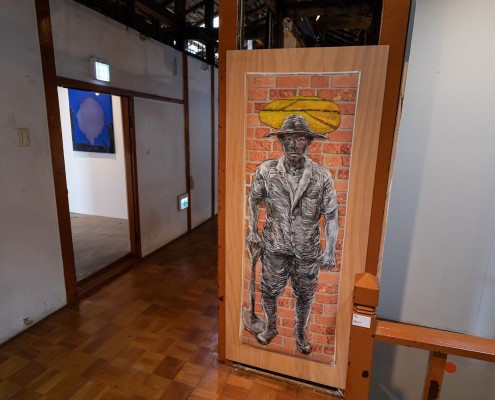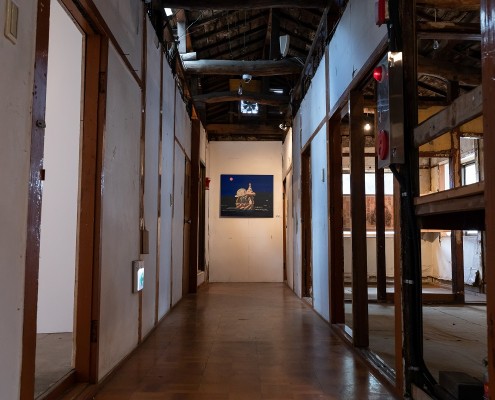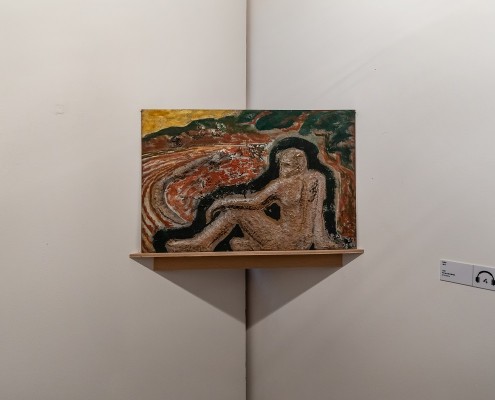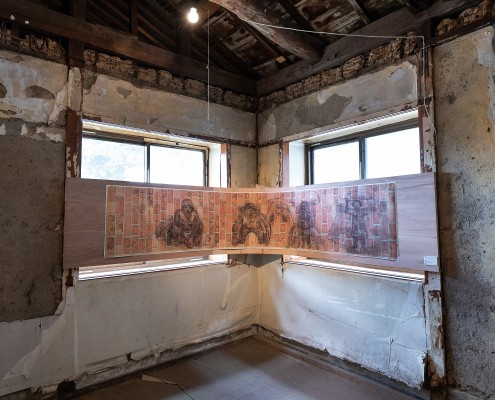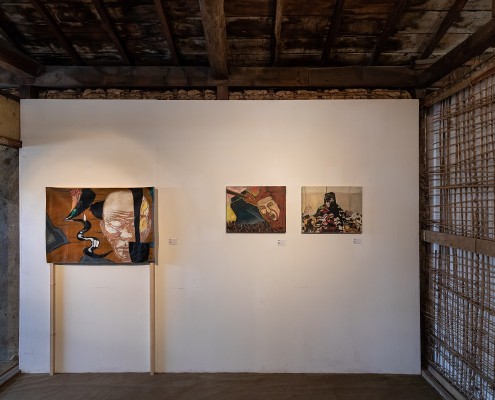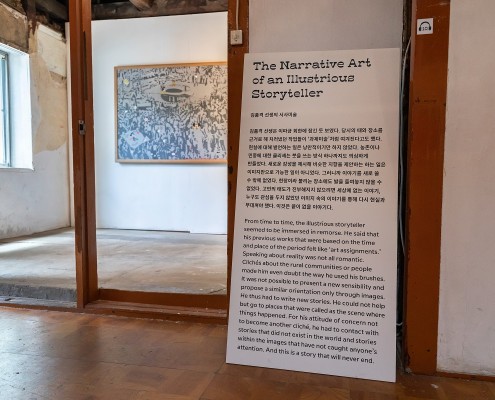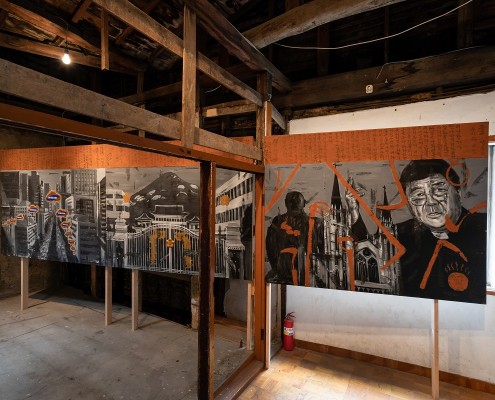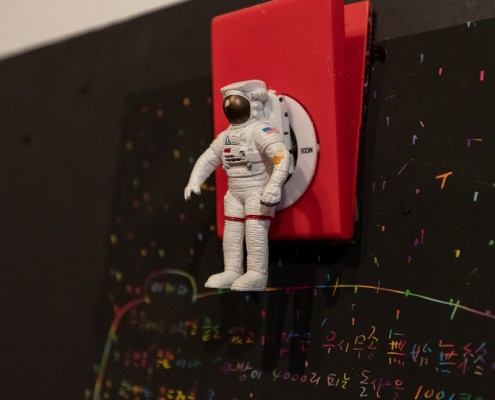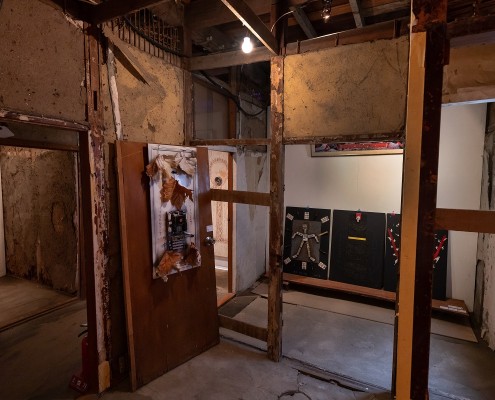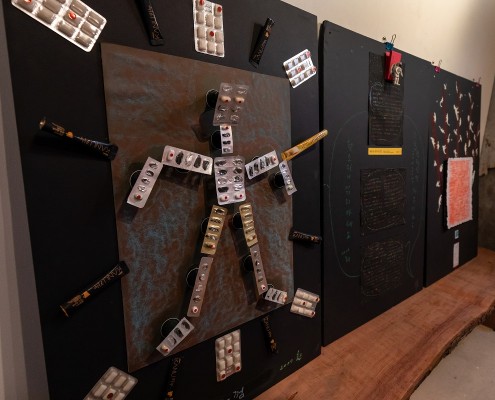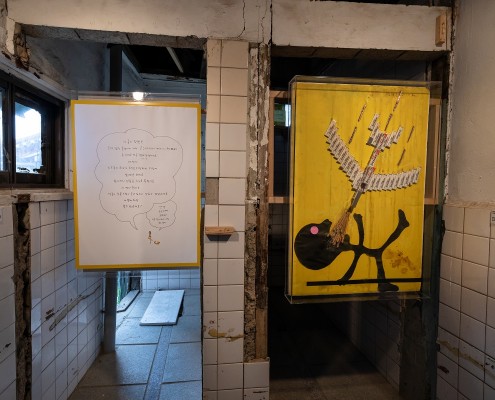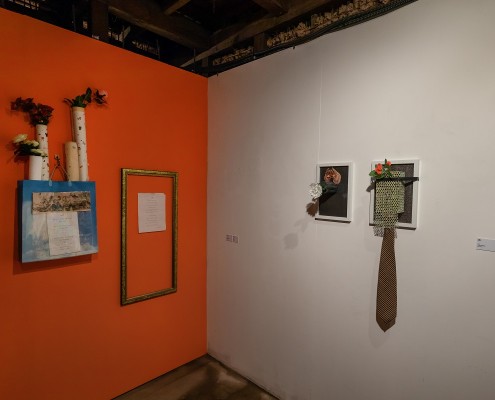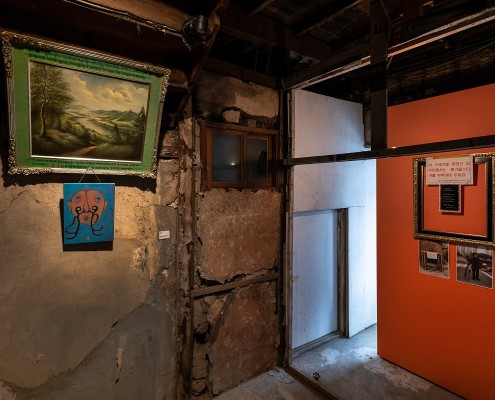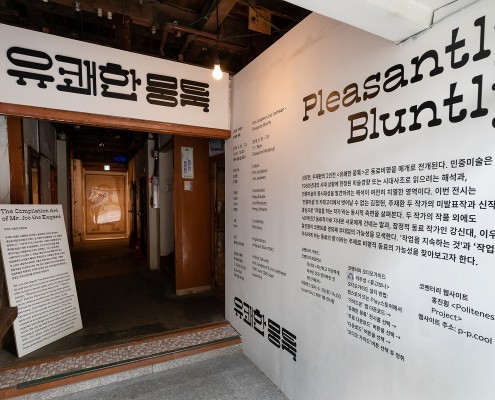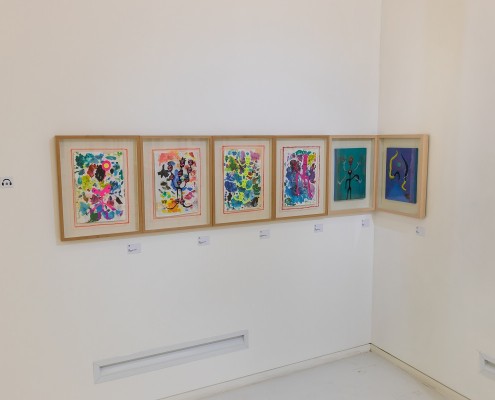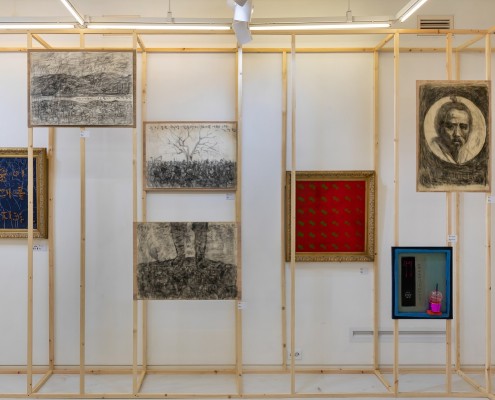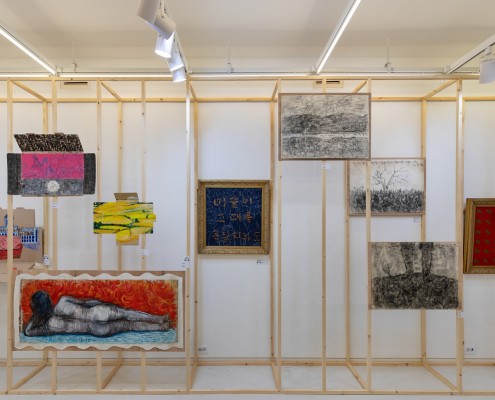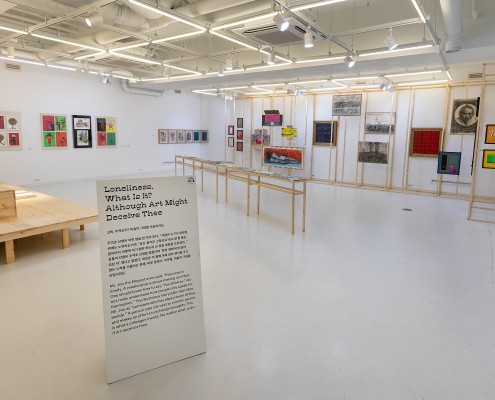김정헌, 주재환의 2인전 <유쾌한 뭉툭>은 동료비평을 매개로 전개된다. 민중미술은 1980년대의 시대 상황에 한정된 미술경향 또는 시대사조로 읽으려는 해석과, 민중미술의 동시대성을 발견하려는 해석이 여전히 치열한 영역이다. 이번 전시는 김정헌, 주재환 두 작가의 미발표작과 신작을 중심으로 ‘작업을 하는 작가’라는 현재적 영역을 들여다본다. 민중미술의 카테고리가 두 작가에게 부여하는 상징과 한계를 뛰어넘고자 하는 전시다. 40여년간 비평적 동료관계로 지내며 작업을 해온 두 작가의 면면을 작품과 두 작가의 발화 행위를 통해 드러내며, 잠정적 동료 작가들(강신대, 이우성, 홍진훤)의 코멘트로 부대낌의 가능성을 모색한다. ‘작업을 지속하는 것’과 ‘작업을 지속하게 하는 동료의 힘’이라는 주제로 비평적 동료의 가능성을 견인하고자 하는 전시다.
Pleasantly Bluntly is a two-person exhibition by Kim Jungheon and Joo Jaehwan. The exhibition unfolds with a peer critique between the two artists. Minjung Misul(the people’s art) is a contested territory where two different views – one that reads it as an artistic trend or the trend of the times that took place under the context of the 1980s and another that tries to find its enduring contemporariness. The current exhibition presents new works and previously unexhibited works by Kim Jungheon and Joo Jaehwan, focusing on their present territory of being ‘working artists.’ In doing so, the exhibition attempts to overcome the symbols that have been given to the artists by the category of Minjung Misul and the limitations that entail. Through the act of speech by the two artists, Pleasantly Bluntly shows different aspects of the artists who have been engaged as critical colleagues for over 40 years. By inviting comments by their potential fellow artists (Kang Sindae, Lee Woosung, and Hong Jinhwon), the exhibition also tries to find a possibility of contact between the two artists and other artists in a different generation. In this way, it attempts to overcome the limitation of Minjung Misul that is being historicized or becoming an established legacy in the Korean art history. At the same time, the exhibition explores the possibility of the relationship of being critical colleagues to each other, presented under the themes of ‘maintaining one’s practice’ and ‘the strength of colleagues that makes it possible for one to keep one’s practice.’
- 2018년 6월 10일 – 7월 8일
- 12:00 – 18:00 (매주 월요일 휴관)
- 참여 작가 / 김정헌 주재환
- 코멘터 / 강신대 이우성 홍진훤
- 기획 / 박수지
- 주관 / 통의동 보안여관
- 후원 / 문화체육관광부, 서울특별시, 서울문화재단
Kim Jungheun Joo Jaehwan – Pleasantly Bluntly
- 6. 10 – 7. 8
- 12-18pm (Closed on Mondays)
- Artists : Kim Jungheun Joo Jaehwan
- Commenter : Kang Sindae, Lee Woosung, Hong Jinhwon
- Curator : Park Suzy
- Organizer : Artspace Boan 1942
- Sponsor / Ministry of Culture, Sports and Tourism, Seoul City, Seoul Foundation for Arts and Culture
오프닝 리셉션 / 6월 10일 일요일 오후 4-6시
오프닝 참석회신 / https://goo.gl/forms/DtIMekFlV4mS7fQt2
.
Opening Reception / June 10, 4pm
Opening RSVP / https://goo.gl/forms/DtIMekFlV4mS7fQt2
작가와의 대화
6월 30일 토요일 오후 4시 boan1942 지하 1층 전시장
우정의 나이, 시대의 동료
박수지
근과거를 돌이켜보는 일은 지루하다. 이를테면 1980년대라는 근과거의 예술이 그렇다. 그 시대는 지금 여기에서 지배적인 담론과 지배적인 이미지로 반복 재생산되고 있을 뿐이다. 때문에 현존하는 근과거의 예술가들은 아카이브라던가, OO주년과 같은 기록과 기념의 프레임 사이에서 ‘지금’이라는 시간성을 빼앗긴다. 원로작가, 살아있는 역사로 불리는 것과 비례해 상품가치의 상승이라는 아이러니에 종속된다. 이미 역사에 기록되었다는 이유로 그들은 권위, 권력, 기성이라는 이름으로 한없이 수렴된다. 상징화되는 것과 동시에 투명해진다. 마치 실존하지 않는 것처럼, 과거의 전유물로서 마땅히 가져야 할 양보와 자중의 역할에 묶여 외딴 방에 기거한다. 그렇다면 그들에게서는 더 이상 지금 이곳이 요청하는 동시대성을 찾아볼 수 없는 것일까?
니체는 <반시대적 고찰>에서 “이 고찰이 반시대적인 것은 시대가 자랑스러워하는 역사적 교양을 내가 여기서 시대의 폐해로, 질병과 결함으로 이해하려 하기 때문이며, 또 심지어 나는 우리 모두가 소모적인 역사적 열병에 고통을 받고 있으며, 적어도 우리가 고통을 당한다는 사실을 인식해야 한다고 믿기 때문이다.”라고 밝혔다. 여기서 ‘역사적 교양’을 무엇으로 읽는지에 따라 근과거의 투쟁인들과 부대끼는 방법론이 달라진다. 이를테면 ‘역사적 교양’을 민주화를 향한 민중적 투쟁 영역으로 해석한다면 근과거의 투쟁인들은 ‘소모적인 역사적 열병’에 시달리는 결함을 내포하는 존재가 된다. 그러나 ‘역사적 교양’을 문명으로부터 파생해 가속화되는 속물적 세계라고 본다면 근과거의 투쟁인들이 요즘의 작업으로 풀어내는 고민은 다분히 동시대적이다.
어떤 관점으로 읽어내느냐는 저마다의 기준이지만 어쨌든 그들과 부대껴야 한다면 어떻게 부대낄 것인가? 이번 <유쾌한 뭉툭>은 김정헌, 주재환이라는 1940년대 생의 작가와 함께 ‘동료비평’이라는 장치로 이 질문을 시작해보는 전시다. 둘은 1979년 현실과 발언에서 만나 40여 년째 동료 작가로 지내오고 있다. 1980년대의 민중미술 그룹에 속했던 동시대인이 겪은 반시대적 자아는 민주화 투쟁, 노동운동과 같은 사회적 연대의 형태로 나타났다. 김정헌과 주재환의 작업이 서로에게는 이국의 언어였을지 몰라도 그 의미의 지향은 같았던 셈이다. 그런데, 김정헌과 주재환의 근작을 민중미술이라고 호명할 수 있는가? 아닐 것이다. 민중미술은 그 당시 활동했던 작가 개인에게서 비롯되는 것이 아닌, ‘그 당시’로부터 출발하는 것이기 때문이다. 두 작가는 우리가 쉽게 ‘동시대’라고 부르는 ‘지금’이 유발시키는 고민들을 지속적으로 탐구해오고 있다. 이는 지금의 젊은 작가 또한 마찬가지다. 다만 고민의 이력과 고민의 방식이 다를 뿐이다.
이번 전시에서는 다른 고민의 이력을 지닌 작가들과 함께 동료비평을 재고하는 장치로 ‘코멘트’를 삽입했다. 김정헌과 주재환은 서로에게 발언한다. 서로를 ‘주격조 선생’이라고 부르거나, ‘걸출한 품격’이라고 일컫을 때의 동료적 지지에 대해 우리는 무슨 말을 할 수 있을 것인가? 전시의 제목에 사용된 ‘유쾌한’은 어느 큐레이터가 주재환에게 건넨 수식어이며, ‘뭉툭한’ 또한 어느 작가가 김정헌에게 건넨 표현이다. 이 수식어는 희한하게도 두 작가에게, 두 작가를 둘러싼 동료들에게 끊임없이 회자되었다. 이렇게 건네진 말이 비평이 되는 지점은 말이 발화된 지점이 아니라 말이 회자되는 때다. 강신대, 이우성, 홍진훤은 코멘터의 역할로 함께한다. 그들은 김정헌과 주재환에게 지난하더라도 시도해볼 만한 비평의 언어를 건네거나, 동료 작가로써 궁금한 것을 질문하거나, 이미 지배적으로 통용되는 두 작가에 대한 말을 재편집한다. 이 셋은 앞선 예술가들의 작업에 빚지고 있는 부분이 분명 있다고 말한다. 그럼에도 이 코멘트는 어떤 친밀함이나 칭송에서 출발하지 않는다.
이러한 상징적인 장치들로 이들의 코멘트가 김정헌, 주재환 두 작가에게 가닿을 것이라고 확신한다면 오산일 확률이 크다. 그렇다면 이 코멘트의 도착지는 어디일까? 예술가는 작품으로 미적 감성을 제시하며, 그 감성을 인지하게 되는 이들이 새로운 주체로서의 이행 가능성을 타진해볼 수 있다고 여겨진다. 그러나 이 모든 과정은 어느 한 명의 위대한 예술가가 모두가 매혹될만한 새로운 감성을 발견해서 어느 날 갑자기 제시하는 일이 아니다. 감성을 제시한다는 것, 그 감성을 인지해서 모종의 가능성을 가늠해본다는 것은 어쩌면 동료적 비평 사이에서 출발한다. 저마다의 불확실한 삶, 불가해한 창작활동이 각자의 궁색함을 드러내기에 급급한 것이 아니라, 서로를 고양시키는 과정이 될 수 있도록 하는 것이 바로 동료비평인 것이다. 비평의 자리를 발견하는 일은 ‘근과거’과 ‘지금’ 사이의 미싱링크를 발견하는 시도이자 동료의 장소를 찾는 일이다. 이 전시는 나이와 시대를 가로지르며 “왜 계속 (작업)하는가”라는 질문을 “어떻게 계속 (작업)해 볼 것인가”로 바꿔볼 수 있는지 묻는다.
Friendship Ages, Colleagues Endure
Park Suzy
Looking back at the recent past is tedious labor. For example, reviewing the art of the recent past called the 1980s is a weary business. Here and now, the 1980s is merely being reproduced as dominant discourses and images. For this reason, working artists from the recent past are deprived of their being in time in between the frames of documentation and commemoration such as archiving and the celebration of anniversaries. As much as they are called as master artists or living histories, they become subordinate to the irony of the increase in their commodity value. Because they are already inscribed in history, they are infinitely drawn to the names of authority, power, and establishment. Questions that are deemed not to meet the values of contemporaries fall into outdated thoughts. As soon as they become symbols, they become transparent. They inhabit in the isolated chamber as if they do not exist, bound to the roles of concession and prudence that are originally reserved as befitting properties of the past. Then, wouldn’t it be possible to find in them the contemporariness in them the contemporariness that is demanded by the present moment?
Nietzsche wrote in Untimely Meditations(1873~1876), “This essay is also out of touch with the times because here I am trying for once to see as a contemporary disgrace, infirmity, and defect something of which our age is justifiably proud, its historical culture. For I believe, in fact, that we are all suffering from a consumptive historical fever and at the very least should recognize that we are afflicted with it.” Here, depending on how one reads the ‘historical culture,’ the methodology of contacting with those who struggled in the recent past also changes. For example, if one interprets the ‘historical culture’ as a field of popular struggle for democratization, those who struggled in the recent past become beings that contain a defect of suffering from ‘a consumptive historical fever.’ However, if one considers the ‘historical culture’ as a snobbish world that derives from civilizations and accelerates by itself, the thoughts presented by those who struggled in the recent past present through their work become quite contemporary.
Everyone can have one’s own perspective, but if one has to be with others, how can it be done? The current exhibition, Pleasantly Bluntly, considers a possible answer to the question with a device of ‘peer critique,’ done by the two artists born in the 1940s – Kim Jungheon and Joo Jaehwan. The two have been working as colleagues for almost 40 years since they first met in the collective Reality and Utterance in 1979. The oppositional ego, experienced by the contemporaries in the Minjung Misul group during the 1980s, was manifested in the form of social solidarity such as the struggle for democratization and labor movement. Although Kim Jungheon and Joo Jaehwan may have seen each other’s work as foreign languages, they had the same direction with regards to the meanings of their works. By the way, can we call the recent works by the two artists as works of Minjung Misul? Probably not. It is because Minjung Misul does not originate from individual artists from the period; it departs from ‘the moment in time.’ Both artists have been continuously exploring the issues raised by ‘the present’ that we easily name as ‘the contemporary.’ For young artists, things are the same. They only differ in terms of how they think about those issues and through which path they have been developing their thoughts.
In this exhibition, ‘comments’ are inserted as a device to rethink peer critique with artists with different histories of thinking about those issues. And Kim Jungheon and Joo Jaehwan talk to each other. The two call each other as ‘Mr. Joo the elegant’ or ‘distinguished elegance.’ What can be said about such mutual support for their colleagues? The word ‘pleasantly’ is given to Joo Jaehwan by one curator to describe him. ‘Bluntly’ is also a word given by an artist to Kim Jungheon. Strangely enough, these two words have constantly been used to describe the two artists and also mentioned by other artists around them. The point at which these words become a critique is not when they are spoken but when they are mentioned by others. For this to happen, Kang Sindae, Lee Woosung, and Hong Jinhwon take part in the exhibition as commenters. They provide a critical language, which might be laborious yet worth trying, to the two artists; they ask the two artists about what they feel curious about as artist colleagues; or they re-edit the words about the two artists that have been already in common use. Kang, Lee, and Hong say that they are clearly indebted to the two artists. Nevertheless, their comments do not start from any intimacy nor praise.
If one is convinced that their comments are perceived as symbolic devices as such by the two artists, it is highly likely that the estimation is wrong. If that is the case, what would the destination of the comments made by artists that take part in this exhibition as commenters? It is believed that artists present aesthetic sensibility through their work, and those who perceive the sensibility can try to explore the possibilities of shifting into new subjects. However, all of this is not something that is suddenly presented by a single artist who in one day discovers a new sensibility that will captivate everyone. Perhaps, suggesting certain sensibility and gauging certain possibilities by perceiving the sensibility is something that starts from the peer critique. Peer critique is not about exposing the destitute. Rather, it is what makes artists’ uncertain life and incomprehensible creative labor become a process of elevating each other. Finding a place for criticism is an attempt to find a missing link between ‘the recent past’ and ‘now,’ and it is also an effort to find a place for one’s colleagues. In the end, the current exhibition shifts the question “Why one continues (creating works)?” into another question “How to continue (one’s creation)?” In doing so, the exhibition traverses artists in different age groups and different historical periods.
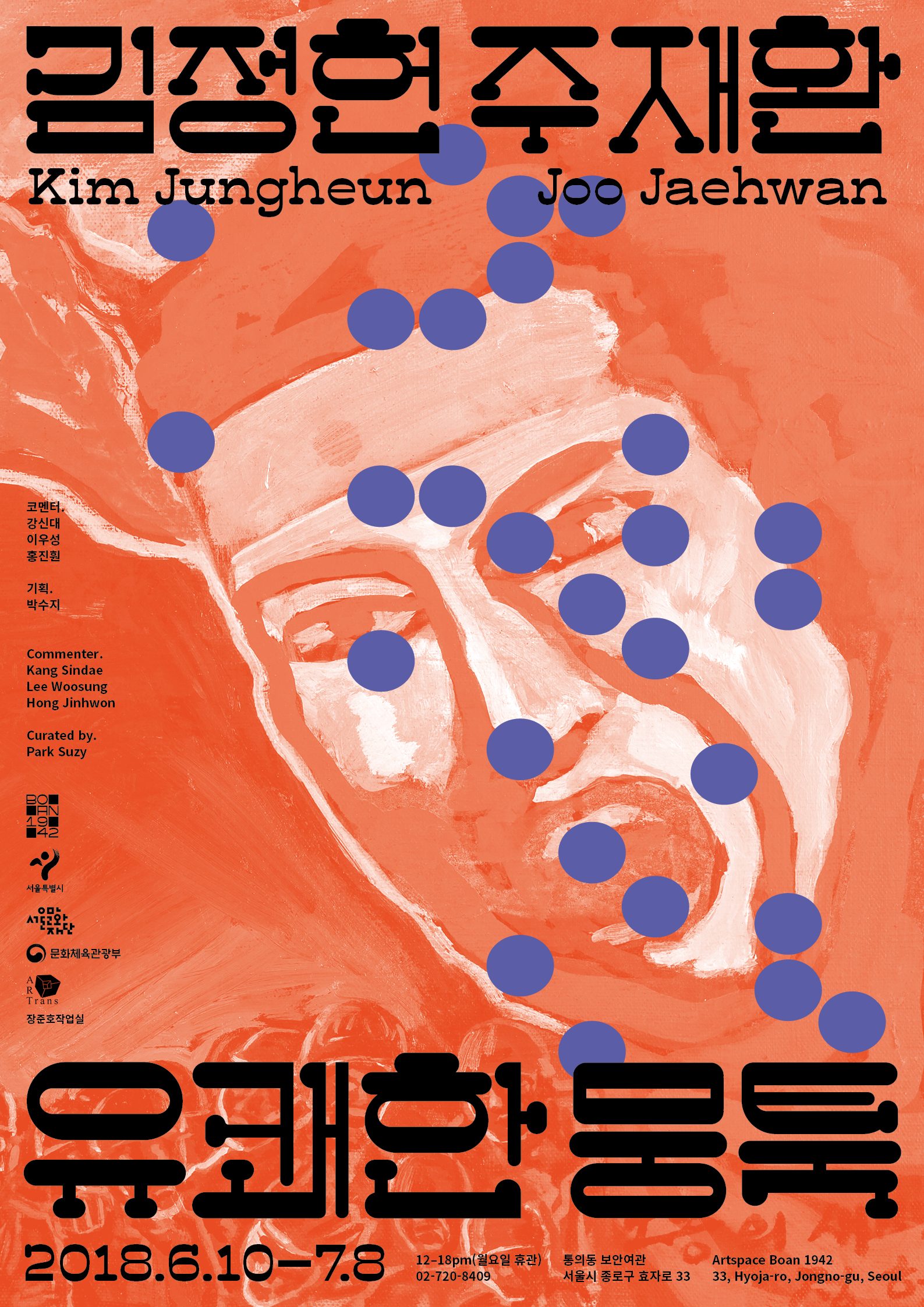
코멘터리 가이드
/ 코멘터리 퍼포먼스 /
강신대 <지난하고 지난하게, 미적인 것과 정치적인 것 어딘가에서>
퍼포먼스 일시 : 6월 30일 토요일 오후 2시 boan1942 지하 1층 전시장
강신대 작가는 주재환과 김정헌의 신작에 초점을 맞춘다. 민중미술이라는 전시장에 동료 비평가들을 섭외해 코멘터리 퍼포먼스를 진행한다. 진지하고 지루하고 지난한 비평을 현장에서 쌓아나간다. 비평의 사회적 위계를 인식하지 않으면서도 진지하게 접근해보기 위해 민중미술이라는 배경을 의도적으로 배제한다. 작품의 시간성을 배제하고 동시적 관점에서 읽어내는 일은 미적인 것과 정치적인 것 사이에 놓인 작품에 대한 질문이기도 하다.
/ 코멘터리 오디오가이드 /
이우성 <듣고보니>
오디오가이드 설치 방법 : 앱스토어 또는 Play스토어에서 ‘가이드온’ 앱 다운로드 – ‘유쾌한 뭉툭’ 전시를 선택 – ‘무료 다운로드’ 버튼을 선택 – ‘다운로드’ 버튼을 선택 – ‘오디오 가이드’버튼 선택 후 청취
그림 그리는 사람 대 그림 그리는 사람으로 질문을 건넨다. 이우성 작가에게 있어 김정헌, 주재환은 일종의 클래식처럼 여겨진다. 의미, 의도, 민중미술 자체에 대한 논의보다는 작업에서는 보이지 않는 과정과 그림을 그리는 방법, 작가로서의 삶에 수반되는 고민들에 대해 질문한다. 관람객은 이우성 작가가 녹음한 오디오 가이드를 통해 김정헌, 주재환 작가에게 건네는 질문을 들으면서 전시를 관람한다.
/ 코멘터리 웹사이트 /
홍진훤
웹사이트 주소 : p-p.cool
김정헌-주재환 작가의 작업에 대해 웹상에서 얻을 수 있는 정보들을 검색하고 아카이브 하는 ‘봇 bot’을 개발한다. 개발한 봇은 전시기간 중에도 계속 데이터를 취합하고 작가도 그 정보들 중 유의미하게 여겨지는 것들을 걸러낸다. 누군가의 작품이나 작업에 대해 어떤 방식으로든 코멘트하는 것들이 과연 그 작업을 읽어내는 데에 도움이 되는가에 대한 질문이다. 홍진훤의 봇에서는 비평가가 쓴 글이든 관람객이 쓴 댓글이든 모두 데이터화 되기 때문에 이러한 플랫폼은 코멘트를 수평적으로 보여주는 방식을 시사한다.
Commentary Guide
Kang Sindae, Lee Woosung, and Hong Jinhwon are participating in Pleasantly Bluntly as commenters. The three young working artists provide a commentary on the exhibition as a way of making a critique. The commentary can be performed by the three artists at the exhibition, and it can also be presented through a website where the existing words and expressions about Kim Jungheon and Joo Jaehwan are collected and linked to each other. Kang Sindae, Lee Woosung, and Hong Jinhwon will also provide guided tours, practicing a peer critique by themselves. The commentary by the three artists does not rely on grand narratives nor quoted references. Rather, it works as a language of potential colleagues. At the same time, it does not function as a unilateral provision of information: It operates as a device capable of interacting between artists and artists, artists and works, works and the curating, and the exhibition and its viewers. It is hoped that the commentary will remain as a common language, not only for the viewers but also for the participating artists.
Kang Sindae
Kang Sindae focuses on the new works by Kim Jungheon and Joo Jaehwan. Kang invites fellow critics to the exhibition and stages a commentary performance. With the performance, Kang builds a critique that is serious, tedious, and laborious at the very site of the exhibition. To approach the exhibition with a degree of seriousness while not observing the social hierarchy of criticism, the performance intentionally excludes the background of Minjung Misul. Excluding the timeliness of a work and reading it from a synchronic perspective is also an attempt to question a work that stands between the aesthetic and the political.
- Performance : 2p.m., June 30 (Sat.) at Boan1942
Lee Woosung
Lee Woosung asks questions from a position of a painter that questions other painters. For Lee, Kim Jungheon and Joo Jaehwan are considered as a kind of classical figures. Rather than asking questions about the meanings and intentions behind the two artists’ works and Minjung Misul itself, he asks the invisible process behind their works, ways through which they create their paintings, and issues that entail their lives as artists. The viewers are invited to listen to Lee’s questions to the two artists – Kim Juengheon and Joo Jaehwan – as they walk through the exhibition.
- Install the Application [Guide On]
Hong Jinhwon
Hong Jinhwon develops a programmed ‘bot’ that collects and archives information about the works by Kim Jungheon and Joo Jaehwan, available on the Internet. The bot continues collecting data during the exhibition period, and Hong selects what is considered as meaningful among the collected data. It is a question about whether making comments on someone’s work helps anyone understand it. The bot turns any collected information into data, regardless of whether it is a critical essay by a critic or comments posted by exhibition viewers. In this way, it suggests a way to present comments on a work of art in a horizontal manner.
- Website : p-p.cool

